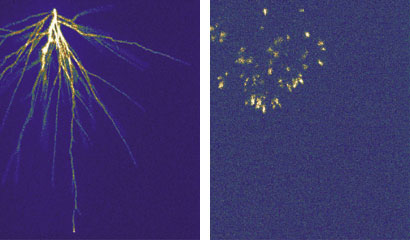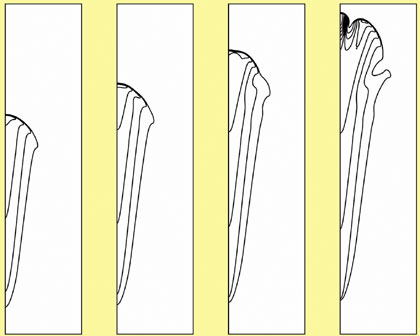|
ERCIM News No.50, July 2002
|
A Simple Model for Spark Branching
by Ute Ebert
Researchers at CWI in Amsterdam have shown that branching of sparks is a direct consequence of the simplest mathematical model describing such electric discharges. This finding is against previous expectations.
The work by Manuel Arrayás (now University of Madrid), Ute Ebert and Willem Hundsdorfer was published in April in the Physical Review Letters. It applies to various natural phenomena, from small-scale sparks on the ground up to the recently observed upward lightning: discharges from a thunder cloud up to the far higher ionosphere occurring on a scale much larger than ordinary cloud-to-earth lightning, and exhibiting a much stronger branching pattern. The study of spark branching is also relevant for combustion gas cleaning or industrial ozone production.
If a strong electric field is suddenly applied to a non-conducting medium like a gas, narrow channels of ionized matter may be formed. Through such a conducting channel the charge surplus at one end (cloud) ‘discharges’ to the other end (earth). The conducting regions emerge because in a sufficiently strong electric field free electrons can ionize gas molecules by impact. One single electron may thus induce a chain reaction. In the field, positive and negative charges then drift into different directions. Hence, electrically charged regions form in particular at the boundaries of the ionized region. These charges modify the externally applied field and therefore the ionization rates and drift velocities, making the problem non-linear. In general, non-linear dynamics leads to spontaneous formation of patterns in space and time. In this particular case, these patterns take the form of narrow channels: in the conducting interior the field is suppressed, while at the tip of the growing channel it is largely enhanced, leading to high local ionization rates and rapid particle drift.
 |
| Figure 1: Two views of a streamer (the phase immediately preceding a discharge). To the left a time integrated picture (exposure time 10-6 seconds); to the right a snapshot of the same event (exposure time 10-9 seconds), showing the propagating heads of the streamer channels. (Courtesy E. van Veldhuizen, Eindhoven University of Technology.) |
 |
| Figure 2: Four snapshots of the evolution of a streamer, resulting from a numerical simulation on the basis of the minimal discharge model studied at CWI. The streamer tip is seen to become unstable and branch. (A. Rocco, U. Ebert, W. Hundsdorfer, CWI.) |
The mathematical model studied at CWI describes the generation and motion of free electrons and ions in a gas under the influence of an external electric field in its simplest form (minimal discharge model). Since the degree of ionization stays low (less than 10-5) we can neglect gas convection and thermal effects. The rate of change in the electron (ion) density then equals the divergence of the local electron (ion) current density, plus a source term representing the generation rate of electron-ion pairs due to the impact of field-accelerated electrons onto neutral gas molecules. This generation rate is proportional to the electron density, but also depends on the local field strength in a non-linear way. It becomes substantial if both the electron density is non-vanishing and the local electric field is sufficiently strong. Since the motion of the free electrons and ions is damped by collisions with the gas atoms, the current is composed of a drift term proportional to the field and a diffusive term.
This simple but realistic model can exhibit already spontaneous spark branching, in contrast to previous expectations. This is revealed by precise numerical simulations at CWI, combined with a new analytical insight: the instability that leads to branching, is of Laplacian type. This puts spark branching into the same class of phenomena as viscous fingering, dendritic solidification or coral growth. The theoretical predictions are presently being investigated in experiments at the Technische Universiteit Eindhoven, where now discharge phenomena on time scales shorter than a nanosecond can be observed.
Please contact:
Ute Ebert, CWI
Tel: +31 20 592 4206
E-mail: Ute.Ebert@cwi.nl
http://www.cwi.nl/~ebert/
